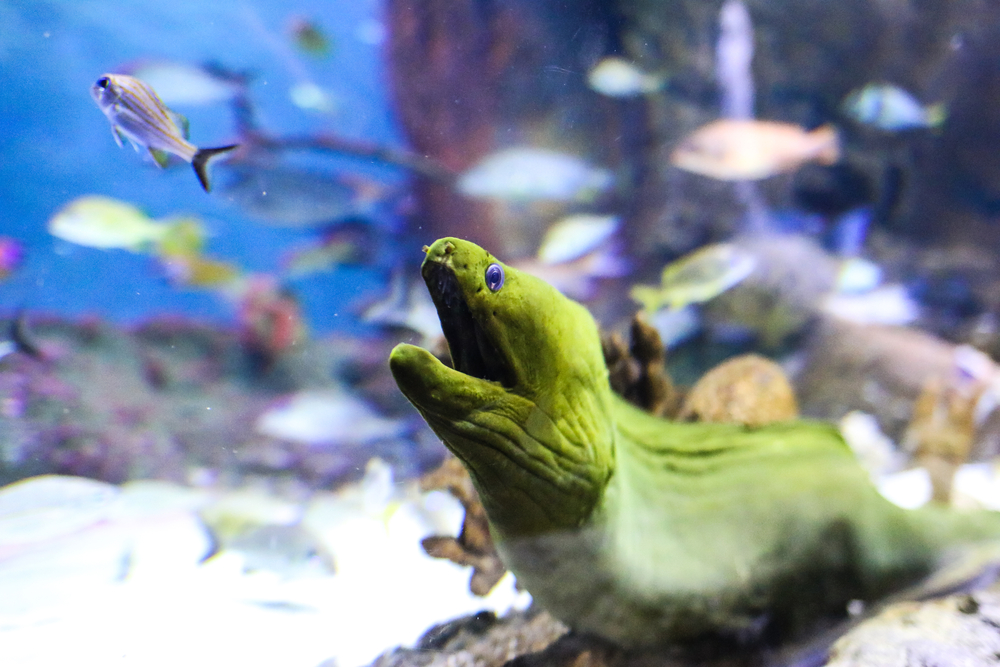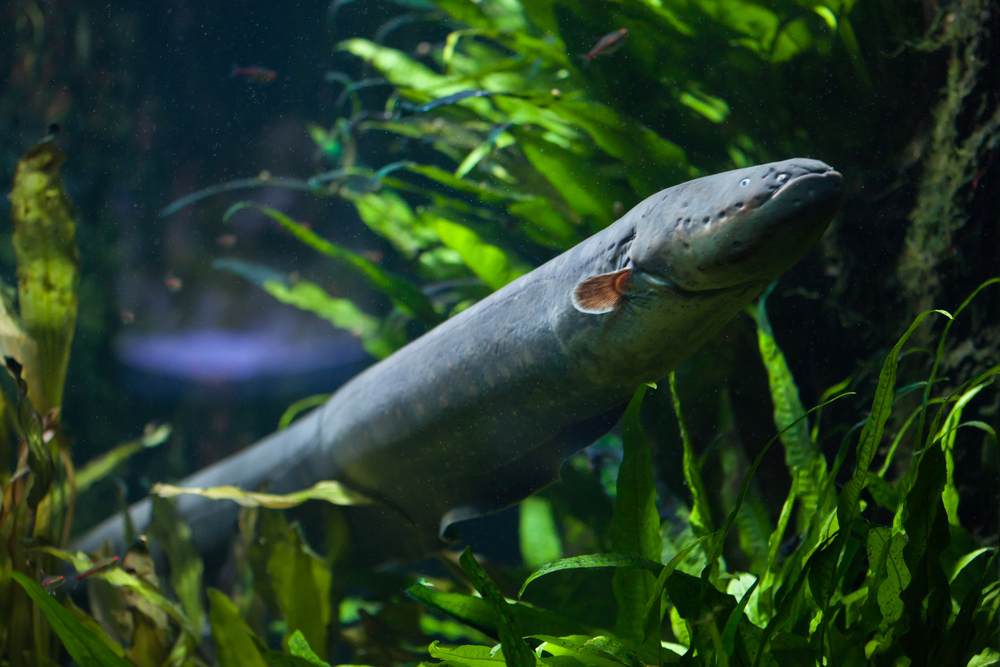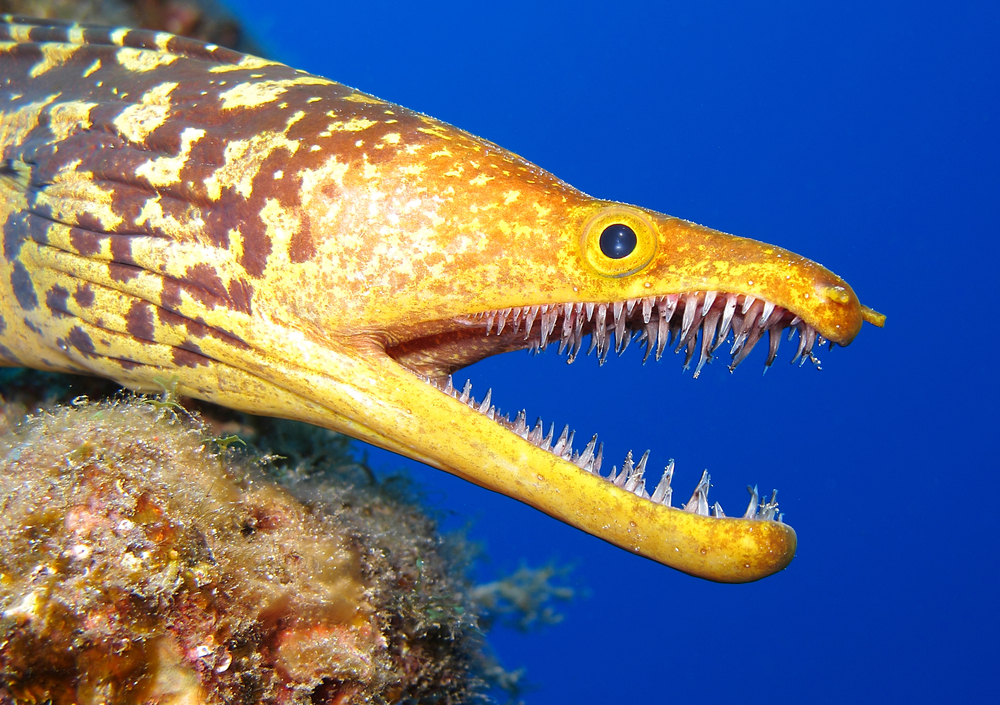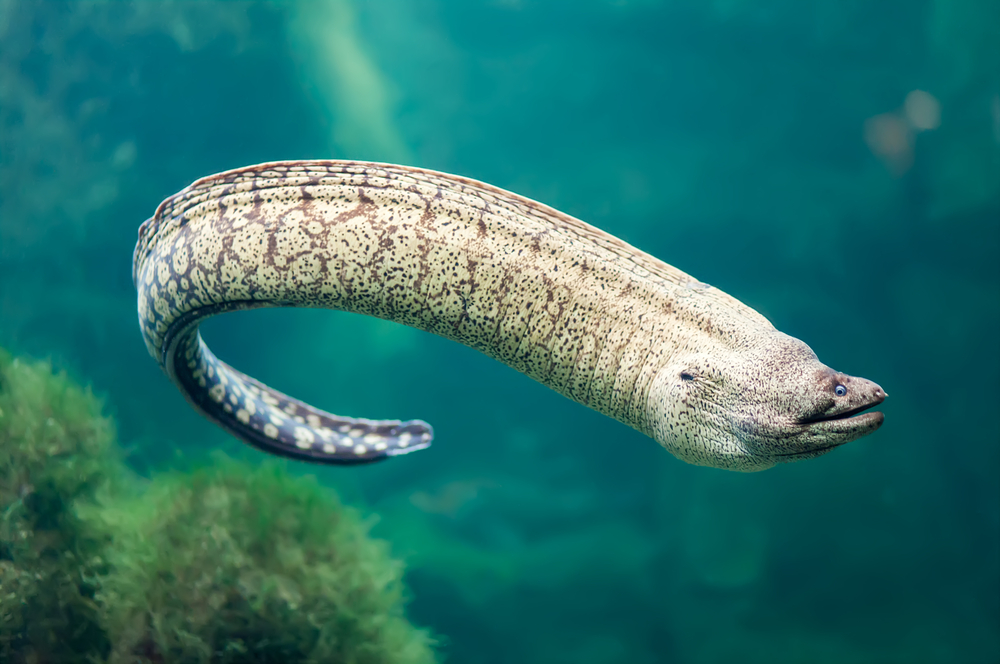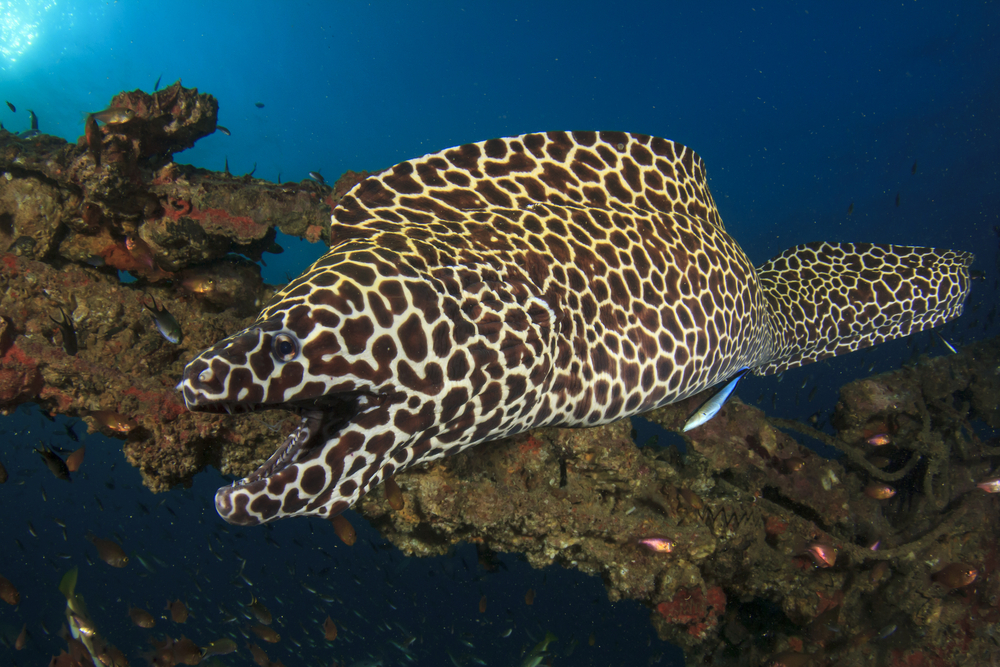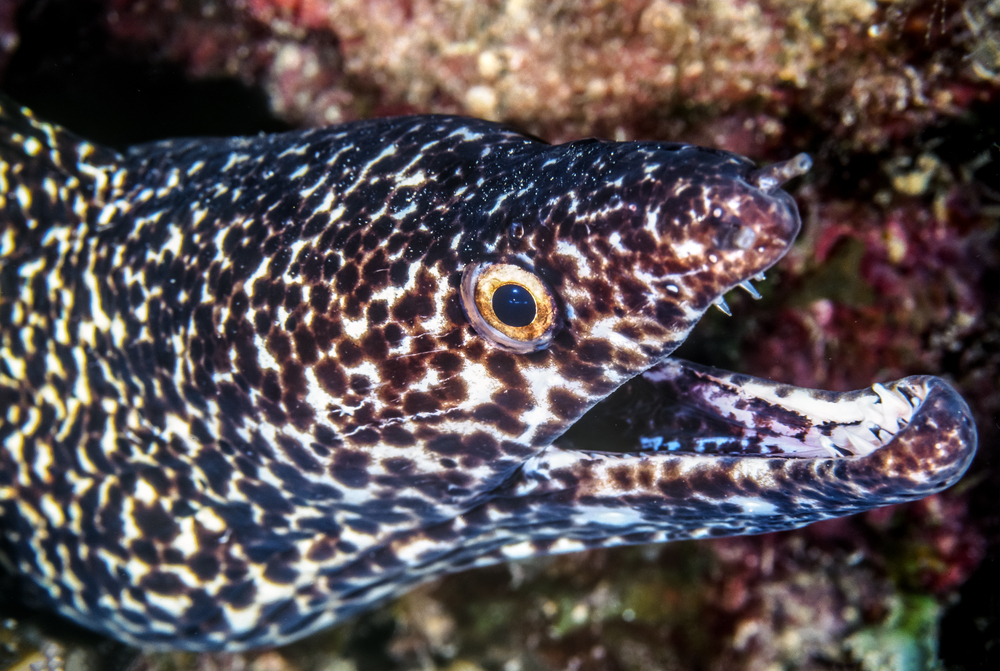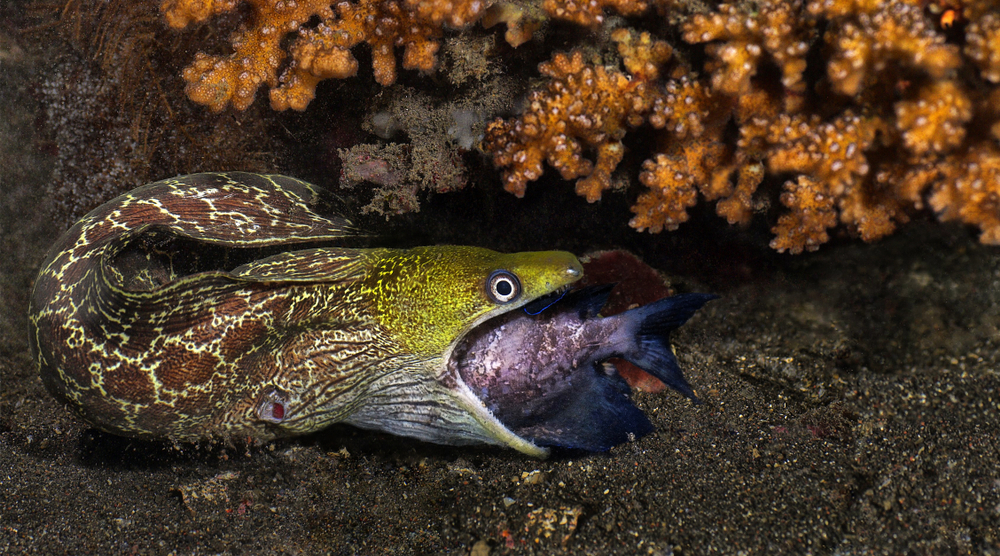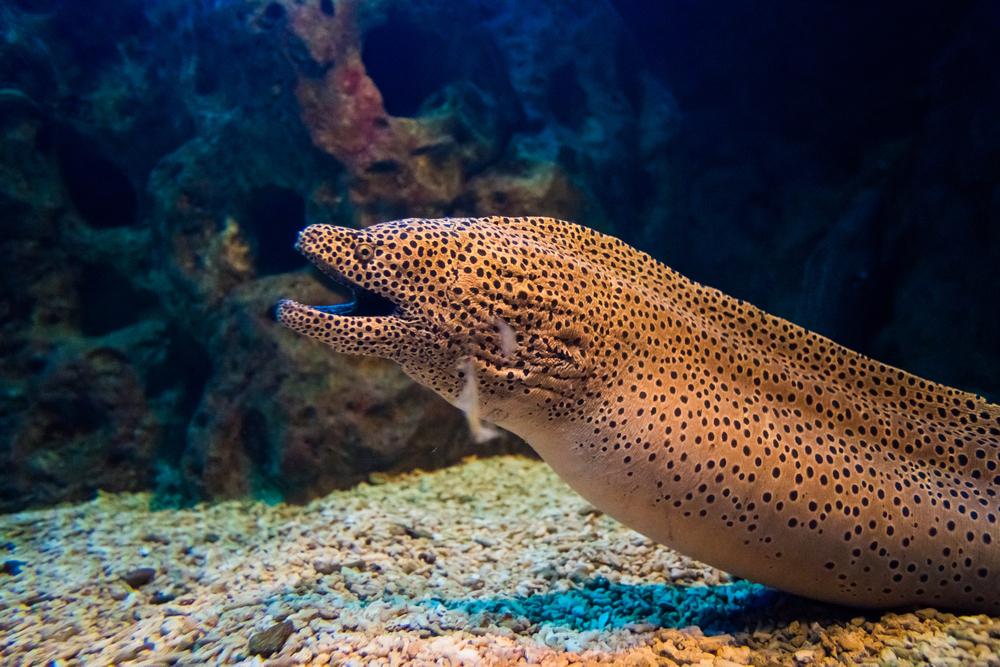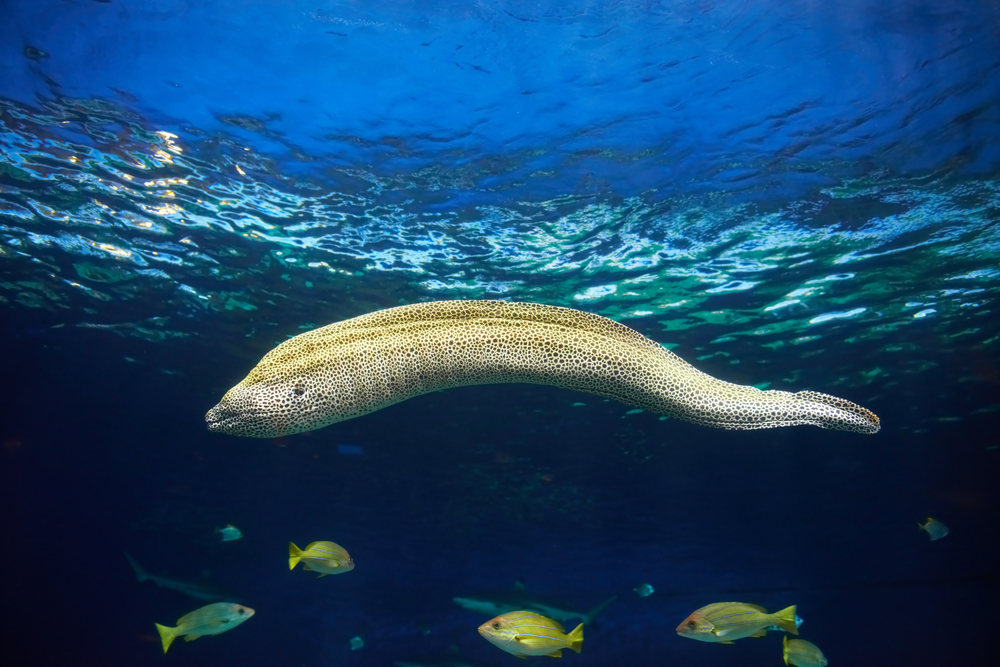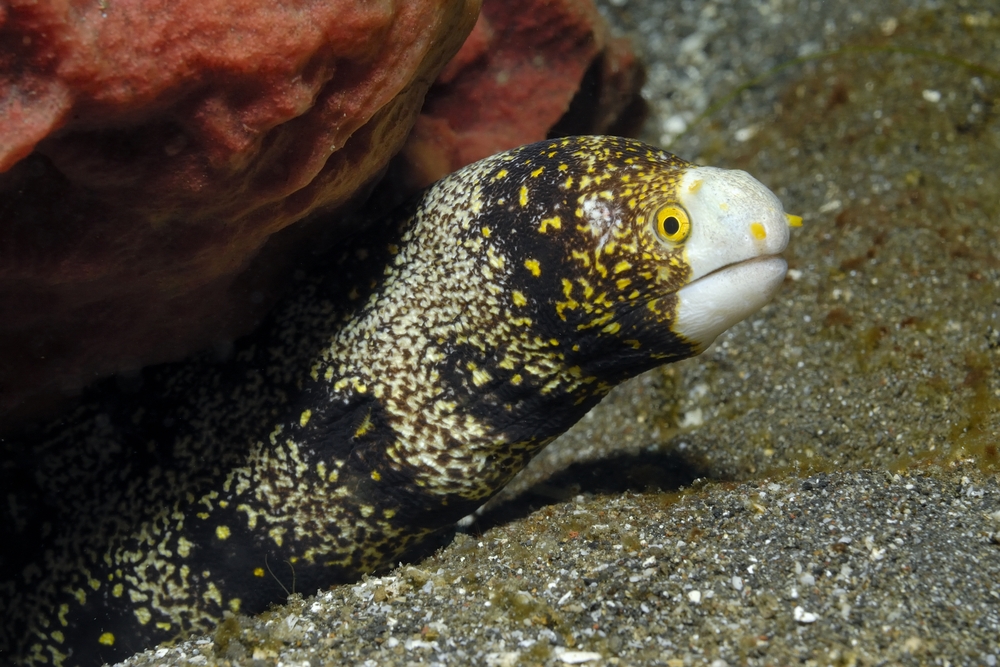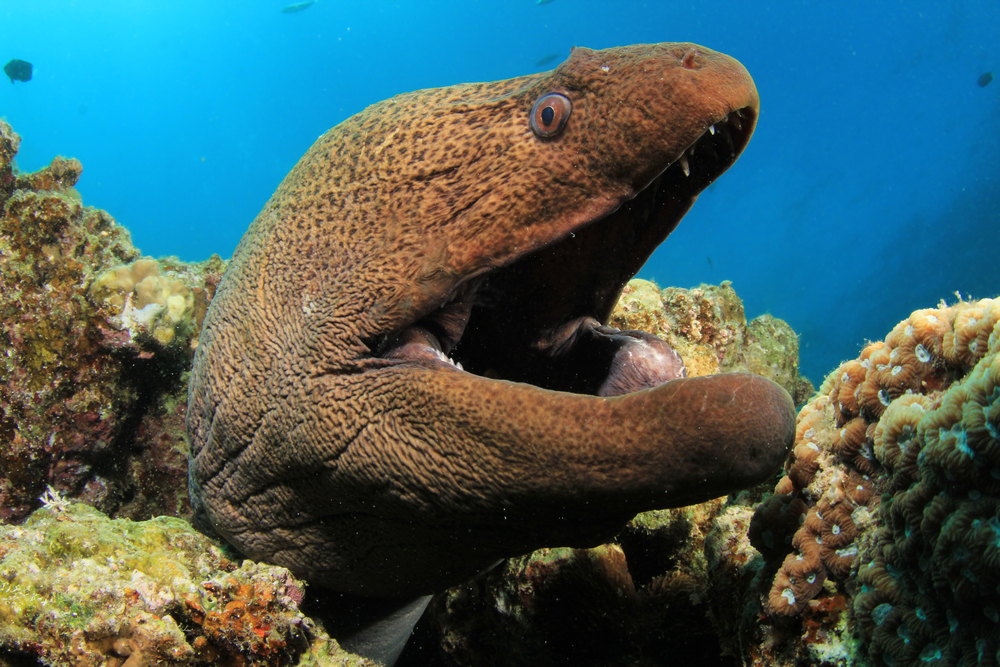About
The Moray Eel, scientifically known as Muraenidae, belongs to the Animal Kingdom’s phylum Chordata and class Actinopterygii, placing it among bony fishes. It is a diverse family of eels, comprising over 200 species found in tropical and subtropical oceans worldwide. Moray eels are closely related to other eel species, such as conger eels and garden eels.
These fascinating creatures are characterized by their long, serpentine bodies, lack of pectoral and pelvic fins, and continuous dorsal and anal fins that extend along the length of their bodies. They possess large mouths filled with sharp teeth, which they use to grasp and immobilize their prey. Moray eels come in various colors and patterns, including shades of brown, green, yellow, and black, often with mottled or spotted markings to blend into their surroundings.
Moray eels are primarily nocturnal predators, hunting for crustaceans, fish, and cephalopods in coral reefs, rocky crevices, and other marine habitats. Despite their intimidating appearance and reputation, they are typically shy and reclusive, preferring to hide in rocky outcrops or burrow into sandy substrates during the day, only venturing out to feed at night.
Conservation Concerns
While moray eels are not specifically targeted by fisheries, they face threats from habitat degradation, overfishing, and pollution. Destruction of coral reefs and coastal habitats due to factors such as climate change, sedimentation, and destructive fishing practices can disrupt their ecosystems and reduce available food sources.
Additionally, moray eels are sometimes caught unintentionally as bycatch in fishing gear targeting other species. Their secretive nature and reliance on specific habitats make them vulnerable to habitat loss and degradation.
Despite these challenges, many species of moray eels are not currently assessed individually on the IUCN Red List. However, given the broader threats to their habitats and marine ecosystems, conservation efforts focused on protecting coral reefs, implementing sustainable fishing practices, and reducing pollution is crucial for ensuring the long-term survival of moray eels and other marine species.
Physical Characteristics
Moray eels, belonging to the family Muraenidae, are a large group of marine fishes known for their elongated bodies, distinctive jaws, and somewhat secretive nature. Found primarily in tropical and subtropical oceans around the world, moray eels are fascinating creatures that inhabit reefs and rocky crevices. While there are over 200 species of moray eels, with a wide range of sizes and colors, they share common physical traits that define the group. Here’s an overview of the physical characteristics typically found in moray eels:
Size
- Body Length: The size of moray eels can vary significantly depending on the species, ranging from as small as 4 inches (about 10 centimeters) to over 13 feet (about 4 meters) in length for the largest species, like the giant moray (Gymnothorax javanicus).
- Weight: Weight is equally variable, with larger species like the giant moray weighing up to 66 pounds (30 kilograms) or more.
Physical Characteristics
- Body Shape: Moray eels have long, slender bodies that are muscular and slightly compressed laterally. This shape allows them to navigate through narrow crevices and holes within reefs where they typically reside.
- Skin: Unlike many other fish, moray eels lack pelvic and pectoral fins, and their skin is smooth with a mucous coating instead of scales. This mucous layer protects them from parasites and helps them slip into tight spaces in the reef.
- Color and Patterns: Their coloration and patterns are highly variable and can include shades of brown, green, blue, yellow, black, and white. Some species have solid colors, while others boast intricate patterns that help camouflage them against the reef.
- Head and Jaws: Moray eels are known for their formidable appearance, with a wide mouth, strong jaws, and sharp, backward-facing teeth designed for gripping and preventing prey from escaping. They have a secondary set of jaws in their throat called pharyngeal jaws, which they can project forward into the mouth to pull prey down their throats.
- Eyes and Senses: Their eyes are relatively small, providing poor vision; however, moray eels have an excellent sense of smell, which they use to detect prey.
- Fins: They have a continuous dorsal fin that extends from the head, along the back, and merges with the caudal (tail) and anal fins, aiding in their serpentine swimming motion.
Behavior and Adaptations
Moray eels are mostly nocturnal, hiding in crevices during the day and emerging at night to hunt. They primarily feed on fish, cephalopods (like squids and octopuses), and crustaceans. The unique pharyngeal jaws of moray eels are a significant adaptation, allowing them to consume larger prey by securing and pulling it into the digestive tract after the initial bite.
Despite their fierce appearance and efficient predatory capabilities, moray eels are shy and reclusive, posing little threat to humans unless provoked. Their ability to blend into their surroundings and their specialized hunting techniques make them formidable predators within their marine ecosystems.
Reproduction
Moray eels, comprising various species within the family Muraenidae, exhibit unique reproductive behaviors influenced by their marine habitat and life history traits. Here’s an overview of their reproductive cycle:
Maturity and Breeding Season: Moray eels reach sexual maturity at different ages, depending on the species and environmental conditions. Breeding seasons vary among species and geographic regions, often coinciding with favorable oceanic conditions and temperature.
Courtship and Mating: The courtship behavior of moray eels is not well documented, but it typically involves olfactory cues and visual displays. Once a suitable mate is found, moray eels engage in internal fertilization through the transfer of sperm from the male to the female.
Egg Production: Female moray eels produce large quantities of eggs, which are fertilized internally by the male’s sperm. The number of eggs produced varies among species, with some species laying thousands of eggs in a single reproductive event.
Egg Deposition: After fertilization, female moray eels deposit their eggs in crevices, caves, or other sheltered locations within their marine habitat. The eggs are often laid in gelatinous masses or strands, providing protection from predators and environmental factors.
Incubation Period: The incubation period for moray eel eggs ranges from several days to several weeks, depending on water temperature and other environmental conditions. During this time, the female may guard the eggs and ensure they receive adequate oxygenation.
Hatching and Larval Stage: Upon hatching, moray eel larvae are transparent and drift with ocean currents as planktonic organisms. They undergo a pelagic larval stage, during which they develop anatomical features and behaviors suited for their eventual transition to a benthic lifestyle.
Settlement and Juvenile Stage: As moray eel larvae grow and develop, they undergo metamorphosis and settle into their benthic habitat. Juvenile moray eels often inhabit shallow coastal waters, where they seek refuge in rocky reefs, coral formations, or other structures.
Growth and Maturation: Moray eels continue to grow and mature throughout their lives, with growth rates varying among species and individuals. Factors such as food availability, habitat quality, and predation pressure influence the growth and development of moray eels.
Reproductive Success and Population Dynamics: The reproductive success of moray eels is influenced by various environmental factors, including oceanic currents, temperature, and prey availability. Understanding the reproductive cycle and population dynamics of moray eels is essential for effective management and conservation efforts aimed at protecting these fascinating marine predators.
Lifespan
Moray eels are a diverse group of elongated fish species belonging to the family Muraenidae. They are found in oceans worldwide, inhabiting coral reefs, rocky crevices, and other underwater habitats. Moray eels are characterized by their serpent-like appearance, sharp teeth, and secretive behavior. Their lifespan can vary depending on species, environmental conditions, and human impacts.
Lifespan in the Wild: In their natural marine habitats, moray eels generally have lifespans ranging from 10 to 30 years, although some species may live longer. Factors such as predation, disease, food availability, habitat quality, and human activities influence the longevity of moray eels in the wild. Larger species tend to have longer lifespans than smaller ones.
Lifespan in Captivity: Moray eels kept in captivity, such as in public aquariums or home aquariums, may have shorter or longer lifespans compared to those in the wild, depending on the species and the quality of care provided. Captive moray eels may benefit from consistent food availability, protection from predators, and veterinary attention, but they may also face stressors such as confinement, water quality issues, and incompatible tank mates.
Threats to the Moray Eel:
- Overfishing: Moray eels are often caught unintentionally as bycatch in commercial fishing gear targeting other species. Overfishing can deplete moray eel populations, disrupt marine ecosystems, and lead to declines in biodiversity. Unsustainable fishing practices, including bottom trawling and dynamite fishing, pose significant threats to moray eels and their habitats.
- Habitat Degradation: Coastal development, pollution, sedimentation, coral reef destruction, and climate change contribute to habitat degradation and loss, negatively impacting moray eel populations. Degraded habitats offer fewer hiding places, reduce prey availability, increase exposure to pollutants and pathogens, and disrupt reproductive behaviors, leading to population declines.
- Climate Change: Rising sea temperatures, ocean acidification, sea level rise, and extreme weather events associated with climate change affect moray eels and their ecosystems. These environmental changes can alter prey distribution and abundance, disrupt reproductive cycles, cause habitat shifts, and increase susceptibility to diseases, resulting in population declines and range contractions.
- Pollution: Marine pollution from sewage, agricultural runoff, oil spills, plastic debris, and chemical contaminants poses significant threats to moray eels and marine biodiversity. Pollutants can accumulate in moray eels’ tissues, impair physiological functions, weaken immune systems, and cause reproductive abnormalities, leading to population declines and ecosystem disruptions.
- Habitat Destruction: Destruction and degradation of coral reefs, mangroves, seagrass beds, and other marine habitats threaten moray eel populations by reducing suitable habitats, disrupting food webs, and increasing vulnerability to predators and environmental stressors. Habitat restoration and conservation efforts are essential for protecting critical habitats and supporting moray eel populations.
- Illegal Wildlife Trade: Moray eels are sometimes targeted for the aquarium trade, traditional medicine, or culinary purposes, leading to overexploitation and population declines. Illegal capture and trade of moray eels can have detrimental effects on wild populations, disrupt ecosystems, and undermine conservation efforts.
Conservation measures, including the establishment of marine protected areas, sustainable fisheries management, pollution control, habitat restoration, public education, and research, are crucial for safeguarding moray eel populations and preserving marine biodiversity. Collaboration between governments, conservation organizations, fishing communities, and other stakeholders is essential for implementing effective conservation strategies and mitigating threats to moray eels and their habitats.
Eating Habits
The Moray Eel is a carnivorous fish belonging to the family Muraenidae, known for its long, slender body and serpentine appearance. These eels are primarily found in tropical and subtropical oceans around the world, inhabiting coral reefs, rocky crevices, and other marine habitats.
Diet: Moray eels are carnivorous predators that feed on a variety of marine organisms, including fish, crustaceans, mollusks, and occasionally other eels. They are opportunistic feeders and will consume whatever prey is readily available in their habitat.
Foraging Behavior: Moray eels are nocturnal hunters, meaning they are most active during the night. They use their excellent sense of smell and keen eyesight to locate prey in the dark underwater environment. Moray eels are ambush predators, often hiding in crevices or burrows and waiting for unsuspecting prey to pass by.
Hunting Techniques: When hunting, moray eels rely on stealth and surprise to capture their prey. They possess a remarkable ability to extend their jaws and swallow prey whole, thanks to their specialized pharyngeal jaws located in the throat. Once a moray eel has seized its prey, it will use its muscular body to coil around the victim, preventing escape.
Prey Selection: The specific prey targeted by moray eels can vary depending on factors such as their size, habitat, and feeding opportunities. Common prey items include small fish, octopuses, crabs, shrimp, and squid. Larger moray eel species may also prey on larger fish or crustaceans.
Dietary Adaptations: Moray eels have adapted to their carnivorous lifestyle through various anatomical features and behaviors. Their elongated bodies, sharp teeth, and powerful jaws are specialized for capturing and consuming prey. Some species of moray eels have secondary sets of jaws called pharyngeal jaws, which help them grip and manipulate prey while swallowing.
Cannibalistic Behavior: In addition to preying on other marine creatures, moray eels have been known to exhibit cannibalistic behavior, especially in captivity or when food sources are scarce. Larger individuals may consume smaller conspecifics (members of the same species) if the opportunity arises.
Opportunistic Feeding: Moray eels are opportunistic feeders and will scavenge for food if live prey is not readily available. They may consume carrion, scraps of food, or even steal prey from other predators if given the chance.
Conservation Concerns: While moray eels are not currently considered endangered, they face threats from habitat degradation, overfishing, and pollution. Degradation of coral reefs, which serve as important habitats for moray eels, can have detrimental effects on their populations. Sustainable fishing practices and marine conservation efforts are crucial for preserving the health of marine ecosystems and the species that inhabit them.
Uniqueness
Moray eels are fascinating and distinctive creatures found in tropical and subtropical oceans worldwide. Here are some key aspects that make moray eels unique:
Serpentine Appearance: Moray eels have long, snake-like bodies with smooth, scaleless skin and a dorsal fin that runs the length of their body. They are known for their large mouths filled with numerous sharp teeth, which are often visible even when their mouths are closed.
Nocturnal Predators: Moray eels are primarily nocturnal hunters, spending the daylight hours hidden in crevices and caves on the reef. At night, they emerge to hunt for prey, which can include fish, crustaceans, and cephalopods.
Exceptional Sense of Smell: Moray eels have a highly developed sense of smell, which they use to locate prey in the dark waters of the reef. Their keen olfactory senses allow them to detect even small concentrations of scent molecules, helping them to find food in their dimly lit environment.
Unique Feeding Behavior: Moray eels are ambush predators, lying in wait for unsuspecting prey to swim by before lunging forward and seizing it with their powerful jaws. They can swallow prey whole, using their muscular throats to push large prey items down into their stomachs.
Flexible Jaws: One of the most remarkable features of moray eels is their extraordinarily flexible jaws. Unlike most other fish, moray eels have a second set of jaws called pharyngeal jaws, which can extend forward from their throat to grasp and manipulate prey. This allows them to swallow prey items that are much larger than their own heads.
Venomous Bite: Some species of moray eels possess venomous bites, which they use to immobilize prey and defend themselves against predators. While most moray eel bites are not fatal to humans, they can cause painful wounds due to the presence of bacteria in the eel’s mouth.
Symbiotic Relationships: Moray eels are known to form symbiotic relationships with other reef-dwelling creatures. For example, cleaner shrimp and cleaner fish often pick parasites and debris from the eel’s skin, providing the eel with a valuable grooming service in exchange for protection from predators.
Variety of Species: There are over 200 species of moray eels, ranging in size from just a few inches to over ten feet in length. They inhabit a wide range of marine habitats, from shallow coral reefs to deep ocean trenches, and exhibit a diverse array of colors and patterns.
Moray eels’ unique adaptations, feeding behaviors, and ecological roles make them fascinating and important components of coral reef ecosystems. Despite their fearsome appearance, they are generally shy and reclusive animals that pose little threat to humans unless provoked.
Related Family Species
Sources
- Britannica, Moray Eel, https://www.britannica.com/animal/moray-eel, retrieved March 2024.
- Burnie, David & Wilson, Don, Animal, Smithsonian Institute, Washington DC.
- Hickman et al, Integrated Principle of Zoology, McGraw Hill, Boston.






























































